Implicit Neural Representations for Breathing-Compensated Volume Reconstruction in Robotic Ultrasound Aorta Screening
MCML Authors
Abstract
Abstract
Ultrasound (US) imaging is widely used in diagnosing and staging abdominal diseases due to its lack of non-ionizing radiation and prevalent availability. However, significant inter-operator variability and inconsistent image acquisition hinder the widespread adoption of extensive screening programs. Robotic ultrasound systems have emerged as a promising solution, offering standardized acquisition protocols and the possibility of automated acquisition. Additionally, these systems enable access to 3D data via robotic tracking, enhancing volumetric reconstruction for improved ultrasound interpretation and precise disease diagnosis.However, the interpretability of 3D US reconstruction of abdominal images can be affected by the patient’s breathing motion. This study introduces a method to compensate for breathing motion in 3D US compounding by leveraging implicit neural representations. Our approach employs a robotic ultrasound system for automated screenings. To demonstrate the method’s effectiveness, we evaluate our proposed method for the diagnosis and monitoring of abdominal aorta aneurysms as a representative use case.Our experiments demonstrate that our proposed pipeline facilitates robust automated robotic acquisition, mitigating artifacts from breathing motion, and yields smoother 3D reconstructions for enhanced screening and medical diagnosis.
inproceedings VAS+24
ICRA 2024
IEEE International Conference on Robotics and Automation. Yokohoma, Japan, May 13-17, 2024.Authors
Y. Velikova • M. F. Azampour • W. Simson • M. Esposito • N. NavabLinks
DOIResearch Area
BibTeXKey: VAS+24



